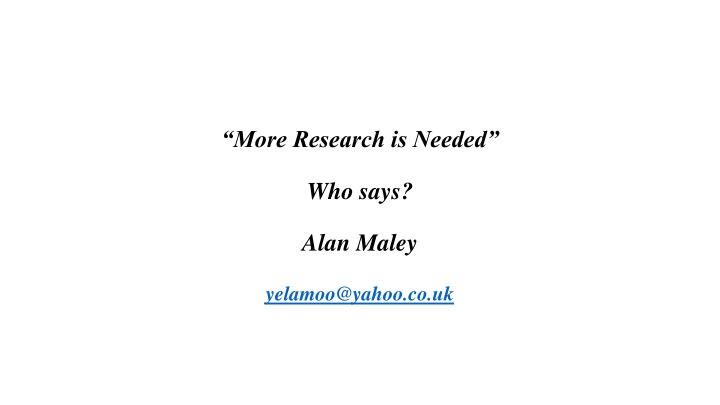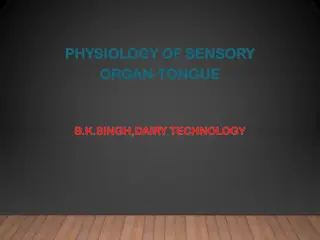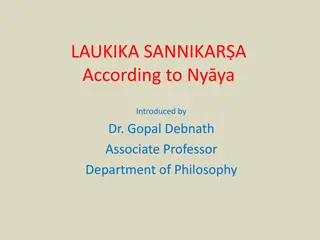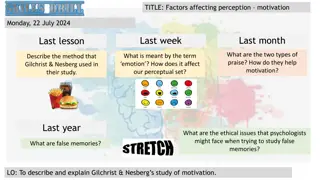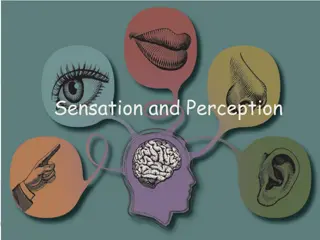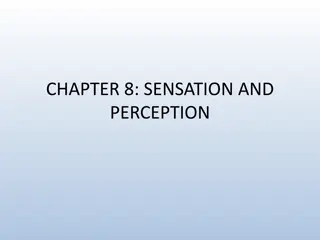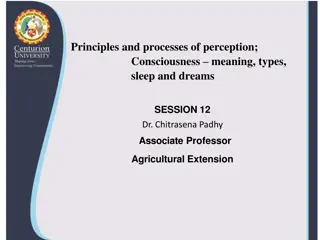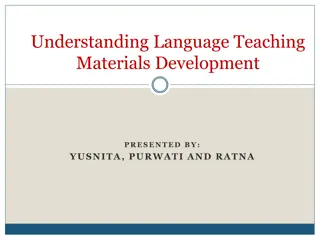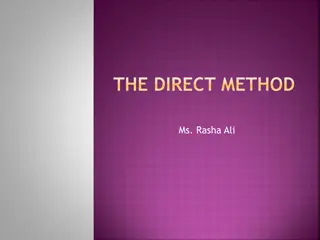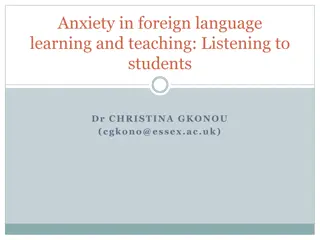Problems with the Perception of Research in Language Teaching
Research in language teaching is often given unjustifiable status, serving the interests of research communities rather than teachers. While some research is valuable, there are issues with relevance, accessibility, and applicability, leading to a disconnect between research and teaching priorities. The sheer volume of research, often hidden in obscure publications and written for insiders, can result in pseudo-research that is not immediately applicable in teaching contexts.
Download Presentation

Please find below an Image/Link to download the presentation.
The content on the website is provided AS IS for your information and personal use only. It may not be sold, licensed, or shared on other websites without obtaining consent from the author.If you encounter any issues during the download, it is possible that the publisher has removed the file from their server.
You are allowed to download the files provided on this website for personal or commercial use, subject to the condition that they are used lawfully. All files are the property of their respective owners.
The content on the website is provided AS IS for your information and personal use only. It may not be sold, licensed, or shared on other websites without obtaining consent from the author.
E N D
Presentation Transcript
More Research is Needed Who says? Alan Maley yelamoo@yahoo.co.uk
Research and teaching. Whats the problem? Research is presented as essential for better language teaching. There is no necessary connection between research and teaching. It is therefore given higher status. This is unjustifiable and it serves the interests of research communities, not teachers. Research is widely touted as valuable for TD. It ain t necessarily so. There are issues with SLA (and other ) research itself. Not always what it s cracked up to be.
This is not to say that research is useless BUT Research and Teaching are different and should be kept apart. (Ur 2014) Teaching is not an inferior form of activity. The current awe in which research is held is damaging both to research and to teaching. There are other ways to develop teaching and teachers. (Aoki 2002) Some research is more relevant / useful than others.(corpus studies, classroom research?)
Research and Teaching: Divergent Priorities. Researchers Teachers abstract thought (future) real-time action (present) d-mode i-mode (Kahneman) seeking truth seeking what works no immediate change immediate change evaluated on publications, evaluated on results perceived influence on field (adapted from Ur)
Good research for teaching has to be: Relevant Reliable Generalisable Comparable Replicable Accessible Communicable Applicable.
So how relevant, accessible and applicable is most AL research? Sheer volume: too much of it Hidden away in obscure publications Written for insiders Often arcane or trivial problems (because of the pressure to publish) Much of it is pseudo-research (eg many MA and PhD theses) Often not immediately applicable
2013 Best Paper Award Collectivity, distributivity and the interpretation of numerical expression in child and adult language. Kristen Strelt and Julian Musolino. A Journal of Developmental Linguistics. Vol 20, Issue 4, 2013. A real page-turner.
Publication: the poison of measurement Give academics citation scores and they will churn out dreary articles for other academics. (Ed Skidelsky: review of Philip Roscoe I Spend, therefore I am Viking 2014.
Fashionable academic twaddle desire in a foreign language is the perceptual disturbance and realignment experienced by the language user, whose identity is constitutive of and constituted by the foreign symbolic system itself. (Kramsch 2009: 16) Yeah, right!
Research: slim pickings. Ten generalizations from SLA research. Lightbown 2000. Cost ~ Benefit, anyone? 1. Adults and adolescents can acquire a second language 2. The learner creates a systematic interlanguage 3. There are predictable sequences in L2 acquisition 4. Practice does not make perfect 5. Knowing a language rule does not mean one will be able to use it in communicative interaction 6. Isolated error correction is usually ineffective in changing language behaviour 7. For most adult Ls, acquisition stops before the L has attained native-like mastery of the target language
continued 8. One cannot achieve native-like command of a second language in one hour a day. 9. The learner s task is enormous because language is enormously complex. 10. A learner s ability to understand language in a meaningful context exceeds their ability to comprehend de-contextualised language and to produce language of comparable complexity and accuracy. Is that all?
Research findings are inaccessible: clinical diagnosis. Citational thrombosis Syntactical constipation Lexical incontinence Stylistic obesity Textual indigestion Cognitive arterial sclerosis Affective anaemia Words easy to be understood do often hit the mark when high and learned ones do only pierce the air. John Bunyan
Useful results but little up-take. Even when research provides useful insights based on empirical data, these are routinely ignored. Examples: Flanders two-thirds rule Best starting age for learning an L2. (Lightbown and Spada 2006) Extensive reading research. (Day and Bamford 1998, Krashen 2004)
Changes in ELT have not been research-driven anyway Most of the big advances , new ideas , etc. of the past 50 years have been on the basis of informed hunch and practical suck it and see . (The work of Wilkins, Widdowson, Brumfit, etc. is more about inspirational reflection and mediating new ideas than about research) ELT is the province of Connectors, Mavens and Salesmen (Gladwell 2000) It has also been driven by publishing, ministerial policy and exams.
Why research is rarely taken up by teachers Insufficient time Accessibility Curricular constraints Cultural issues Apathy/conservatism. Wot s dat got ter do wiv me?
Some negative effects of the unequal power relationship Misplaced feelings of superiority in the research community. Correspondingly low self-esteem among teachers. Hence teachers are tempted out of what they are good at into research, with consequent loss of competent teachers. And promotion of real talent can be blocked by the gatekeepers (PhD treadmills etc.) Mistaken idea that TD should be based on action-research Trivialisation, pseudo-research and unnecessary duplication of research efforts.
Some alternatives to research for teacher development Talking shops (Aoki 2002) Attitude of Inquiry (Maley 2003) Materials development (Tomlinson 2014) Mediation (Ur 2014) Exploring preparedness (Underhill and Maley 2012, Underhill 2014)
Research or inquiry? Purpose Research Inquiry Theory-building Problem-solving Future value Immediate value Academic Pragmatic Global Local Commitment to research Commitment to learners community Sense of certainty Sense of plausibility
Research or Inquiry: Who does it? By outsiders (Them) By insiders (Us) By experts By practitioners impersonal Personal Top-down Bottom-up
Research or Inquiry: How is it done (and for how long)? Closed-ended Open-ended Finite Continuing Narrow-focus Holistic Generalisable Segregated Integrated Scientific Intuitive Epochal Incremental Particularised
Some questions to think about: Research is predicated on the credo that all conclusions should be empirically justified. Has the assumption that research in ELT is of prime value ever been empirically tested? In what sense, if any, can the social sciences be considered science? Do we need more information or more inspiration? More data or more wisdom?
Some references Aoki, Naoko (2002) An alternative way for teachers to develop. The Teacher Trainer, Vol 16, No 2, Summer 2002 :10-11 Day, R. and J. Bamford (1998) Extensive Reading in the the Second Language Classroom. Cambridge University Press. Gladwell, M. (2000) The Tipping Point. Abacus. Kahneman, D. (2011) Thinking , Fast and Slow. Allen Lane, Penguin Krashen, S. D. (2004 second ed.) The Power of Reading: insights from the research. Heinemann. Lightbown, P.M. (2000) Anniversary Article: Classroom SLA Research and Second Language Teaching. Applied Linguistics 21/4:431-462.
more references Lightbown, P.M. and N. Spada. (2006 3rdedition) How Languages Are Learned. Oxford University Press Maley, A (2003) a Modest Proposal: from research to inquiry. Humanising Language Teaching. Year 5, Issue 5, Nov. 2003 Tomlinson, B. (2014) Teacher growth through materials Development. TESOL Teacher Education and Development: Special number of EJALELT 3 (2) Underhill, A. (2014) Training for the unpredictable. TESOL Teacher Education and Development: Special number of EJALELT 3 (2) Underhill, A and A.Maley (2012) Expect the unexpected. English Teaching Professional. Issue 82, Sept. 2012 Ur, P (2014) Practice and Research-based Theory in English Teacher Development. TESOL Teacher Education and Development: Special number of EJALELT 3 (2)
Thank you for listening. Alan Maley yelamoo@yahoo.co.uk The C Group http://thecreativitygroup.weebly.com
